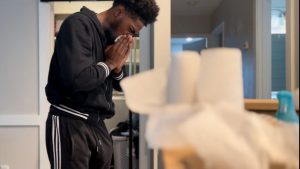Deja Davis
Managing Editor
Breast Cancer awareness during the month of October is not only for women, men can also contract the deadly disease.
In 2019, about 2,670 men are expected to be diagnosed with the disease and for men, the lifetime risk of being diagnosed with breast cancer is 1 in 833 according to breastcancer.org.

Men at any age may develop breast cancer, but it is usually detected in men between the ages of 60 and 70.
Even though college students have not reached this age yet, it is still important for young men to be knowledgeable of what is going on with their bodies.
According to the American Cancer Society, breast cancer is 100 times less common among white men than among white women. It is also about 70 times less common among black men than black women.
But because males also have breast tissue; breast cancer can also develop.
Male breasts are made up of small undeveloped breast tissue and a small amount of connective tissue behind their nipple.
Caused by puberty, male hormones stop the growth of breast tissue, but cancer can develop in the developed tissue that began the process of growing before puberty.
The most common type of breast cancer in men, as in women, is Infiltrating Ductal Carcinoma, which occurs when the cancer has spread beyond the cells lining ducts in the breast.
Even though there is a 1 percent chance for a male to get breast cancer, it is still imperative for everyone to know their risks.
A few male students at JSU shared their input on breast cancer.
Mark Carter, a senior therapeutic recreation major from Clarksdale, Miss. expressed, “I had no idea that men could get breast cancer at all simply because I thought it was just a woman thing.”
Carter continued, “I believe that this type of information needs to have more awareness than it does because it is overlooked in our community and to most men in general.”
“Breast cancer is nothing to play with at all, and now that I know that men can also get it makes me want to be really cautious with a lot of things,” said William Hawkins, a senior elementary education major from Dayton, Ohio.
Hawkins added, “Even though it is a one percent chance, it is still important to make sure you get checked for everything to know what is going on with your body at all times, because you never know what could happen.”
Experts do not know exactly why cancer develops in the breast, but they identified risk factors such as genetic and environmental.
It is so important for young men and women to seek help especially if there are noticeable changes, as well as know how to recognize the signs so the disease can be treated early.
Some possible symptoms of breast cancer include:
- A lump in one breast, which is usually painless but may be tender
- Nipple retraction, ulceration, and discharge
- Skin puckering or dimpling on the breast
- Redness or scaling of the skin on the breast or nipple
The National Breast Cancer Foundation also provides free early detection screenings and diagnostic breast care services, including mammograms and regular breast exams done by professionals.
Remember to take control of your health, and help reduce your cancer risk!




Be First to Comment